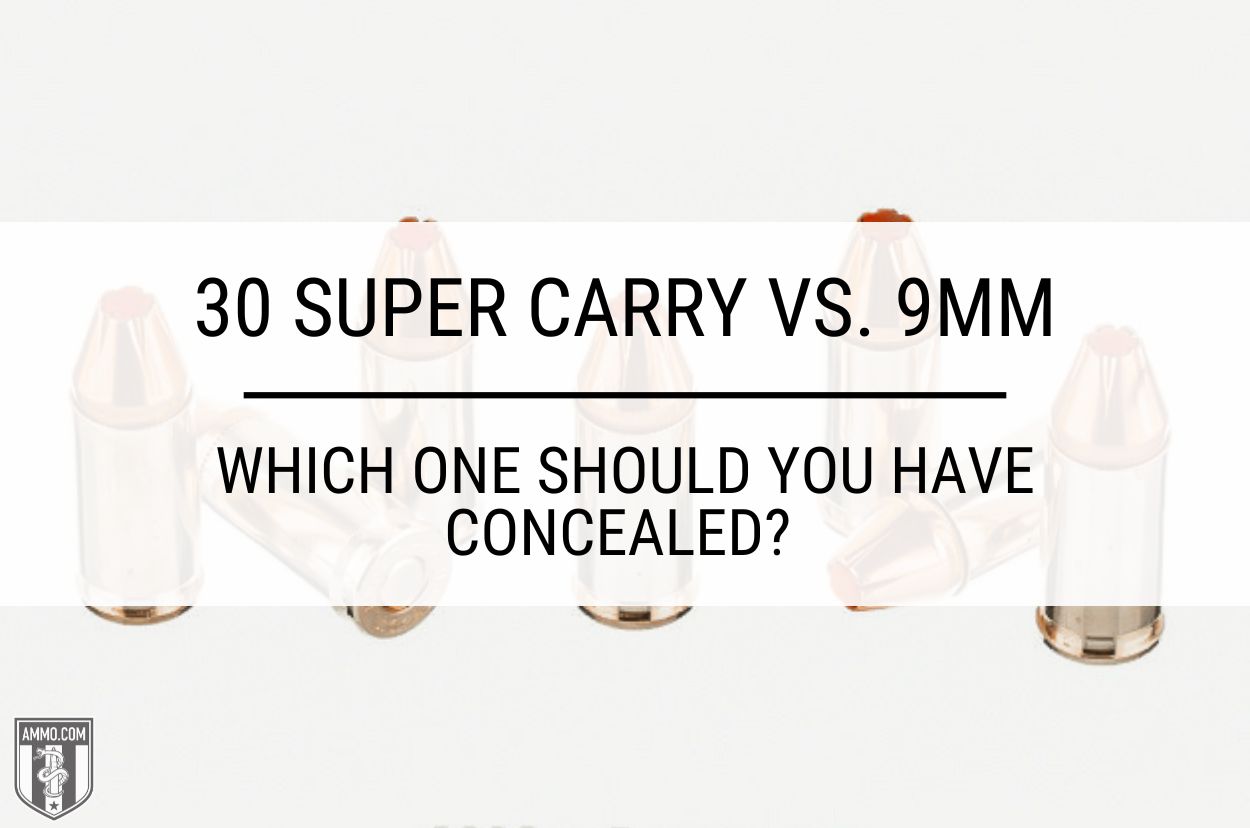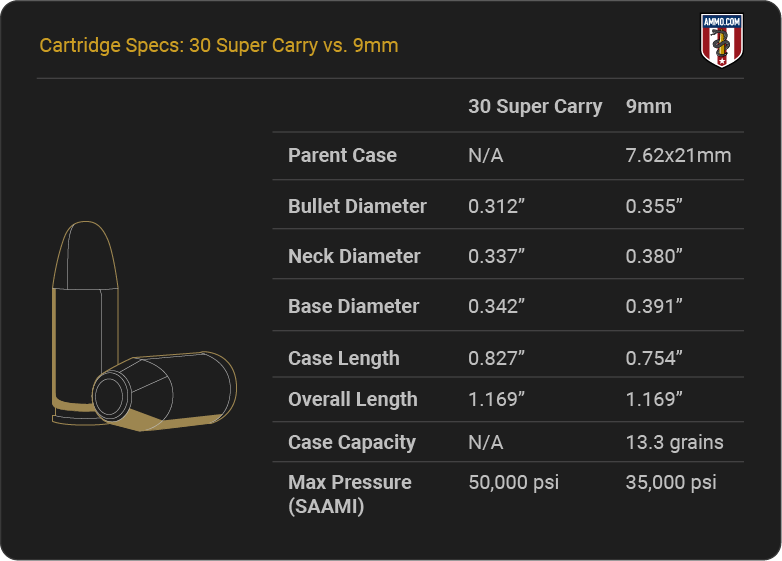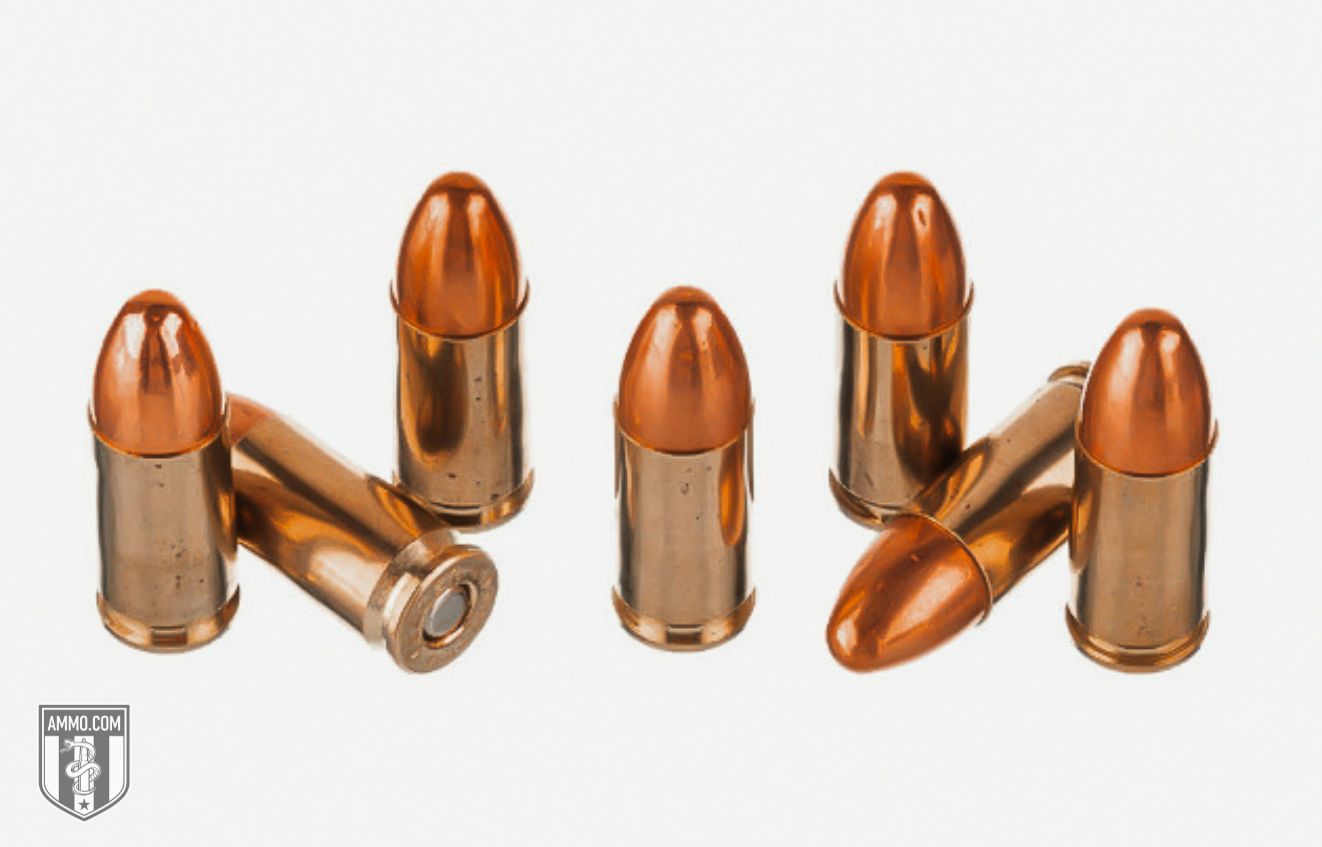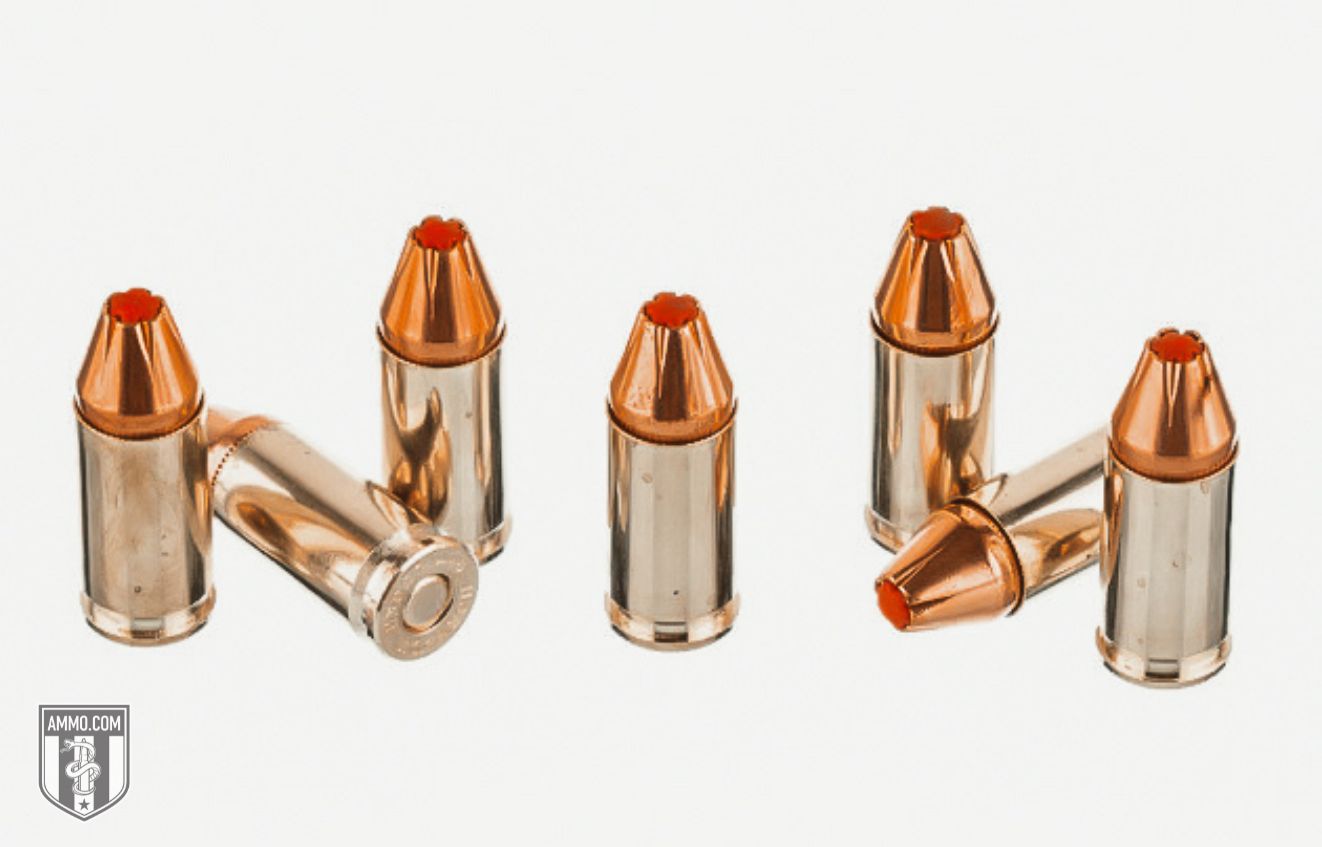30 Super Carry vs. 9mm: Which One Should You Have Concealed?
 It’s only natural to compare the 30 Super Carry vs. 9mm. After all, the .30 Super Carry was designed to offer gun owners a higher magazine capacity than the 9mm and better ballistic performance than the 380 ACP.
It’s only natural to compare the 30 Super Carry vs. 9mm. After all, the .30 Super Carry was designed to offer gun owners a higher magazine capacity than the 9mm and better ballistic performance than the 380 ACP.
Is that actually possible? Can a new cartridge outperform the time-tested 9mm Luger? Or should you stick with the tried and true concealed carry option?
Let’s find out!
30 Super Carry vs. 9mm
The Federal 30 SC is a new cartridge that aims to fill the capacity and performance gap between the 9mm and 380 Auto.
Many self-defense enthusiasts have preferred the 9mm over the decades. Has its reign finally ended?
As we continue, you’ll discover the differences and similarities in cartridge specs, recoil, trajectory, accuracy, stopping power, and other important categories. We’ll finish it all off by crowning a winner.
Technical Specs: 9mm vs. 30 Super Carry

As they’re designed to fulfill a similar purpose, it’s no surprise that the 9mm and 30 Super Carry have similar characteristics.
The much older 9x19mm was based on the 7.62x21mm. Federal Premium claims that the 30 Super Carry is an original handgun cartridge design. It resembles the 7.65mm French Long, .30-18 Auto, and 7.65x20mm Long.
The 30 Super Carry's bullet diameter is 0.312 inches, compared to 0.355 inches for the larger 9 mm. The case lengths vary slightly, with the Federal 30 SC being marginally longer at 0.827 inches and the 9mm at 0.754 inches. The Federal .30 Super Carry also has a higher maximum pressure: 50,000 psi, as opposed to the 9mm at 35,000 psi.
Both cartridges have an identical overall length of 1.169 inches. The smaller base diameter of the 30 SC helps shooters differentiate the two cartridges.
Recoil
Recoil is an important consideration when purchasing a new cartridge or handgun, as a heavy recoil round is more difficult to control and slows the rate of your follow-up shots. You’re also at an increased risk of flinching when firing heavy-recoil loads.
Felt recoil is subjective, differing from shooter to shooter and depending on the firearm, stance, handloads, or factory ammo. However, free recoil is a more objective measure of the amount of kick a cartridge delivers. It is based on four factors: firearm weight, muzzle velocity, propellant weight, and bullet weight.
Neither cartridge is known for heavy recoil, as this (along with increased capacity) is why many shooters opt for 9mm over 45 ACP for self-defense. Since both cartridges are chambered in the same pistols (Smith & Wesson Shield EZ has a 9mm version and a 30 Super Carry version), we can objectively compare the recoil of each.
The 30 Super Carry is consistently considered to have less felt recoil than the 9mm. This is thanks partly to the 30 SC’s lighter bullet: 100 grains, as opposed to the 9mm’s usual 115-147 grains. The 9mm only has 4 ft-lbs of free recoil; however, the 30 Super Carry has 3.8 ft-lbs of free recoil.
Though the 30 Super Carry has slightly less recoil than the 9mm, it’s not significant enough for you to notice a difference while firing the rounds. This section is a draw.
Accuracy
Many factors determine a round's accuracy, including (but not limited to) the shooter, bullet design, trajectory, firearm, recoil, and shooting conditions.
Since these rounds are so similar in many respects, it ultimately comes down to the shooter. The 30 Super Carry cartridge has less recoil by a hair, but I don’t believe this difference is significant enough to affect your accuracy.
Most shooters will find the 30 SC and 9mm to be accurate. I’m very accurate with my 9mm pistols within 25 yards, which is the range most self- and home-defense situations play out over.
This section is a draw, as both rounds are similarly accurate.
Stopping Power
“Stopping power” is another evasive term. No one can truly define what it means. Some shooters consider it the ability to penetrate, while others say it’s the size of the hole the bullet leaves in the target. Another group of shooters will say it’s the amount of energy transferred to the target.
If we are talking about the ability to penetrate, the 30 SC and 9mm pass the FBI standards of a minimum of 12 inches and a maximum of 18 inches. The Federal Premium HST 100 grain 30 SC tends to penetrate ballistics gel 15.5 inches on average, and the Federal HST 124 grain 9mm Luger penetrates about 14.5 inches on average.
The 9mm will also create a slightly larger hole. Still, the expandability of modern JHPs often negates this argument, as quality JHP can make a hole capable of stopping any threat. Also, small-caliber bullets are just as deadly as larger projectiles with proper shot placement.
The 9mm uses heavier projectiles, often translating into more muzzle energy. More energy at the muzzle means there is the potential for more energy to strike the target. Other factors can and do determine terminal performance, so remember that this is a broad generalization. For example, the 30 SC tends to have a higher muzzle velocity, and velocity also contributes to energy transfer into a target.
The stopping power of these two rounds is incredibly similar and shouldn’t be of significant concern. The 9mm has been proven to end threats quickly when needed, and the 30 SC has many of the beneficial attributes of the 9x19mm NATO regarding stopping power.
This section is a draw because both cartridges can efficiently end threats.
Self-Defense
The Federal Premium 30 Super Carry was explicitly designed for self-defense. Georg Luger designed the 9mm Parabellum for warfare, although it has remained one of the leading self-defense cartridges for decades.
The advantages of a .30 SC carry gun are the higher magazine capacity (2 more rounds) for a pistol of the same size as a 9mm pistol and the slightly reduced recoil.
The advantages of a CCW chambered in 9mm are increased ammo and firearm options and lower ammo costs, which we’ll discuss further in the next section.
We won’t end the new debate today, as this section is a draw. Both cartridges are more than capable of self- or home defense.
30 Super Carry vs. 9mm Cost & Availability
Since you read the section above, you know this is where the 9mm continues to have an advantage.
9mm ammo costs less than 30 Super Carry ammo. This is because the 30 Super Carry is still a relatively new cartridge, and not many ammunition manufacturers are producing it. This also means it’s harder to find.
Fewer guns are chambered in 30 SC, so your options will be limited in that regard as well. The Smith & Wesson M&P Shield Plus, Smith & Wesson Shield EZ, Nighthawk Custom 1911, and Hi-Point Carbine were some of the first.
The 9mm is chambered in many sub-compact and full-size firearms from manufacturers such as Sig Sauer, Ruger, Remington, Winchester, Springfield Armory, Smith & Wesson, and who can forget Glock. That’s just the tip of the iceberg. Many of these firearms are less expensive (or, at the very least, comparably priced) to a 30 SC pistol.
Because the 9mm is better established, it generally costs less and is more available than the 30 Super Carry. That could change if the 30 SC grows in popularity over the coming years, but the forecast is grim.
Reloading
While information, materials, and supplies are available to reload 30 Super Carry, they pale in comparison to 9mm. Because of the information and supplies available, 9mm is one of the most accessible cartridges to reload.
If shooters eventually embrace the benefits of the 30 Super Carry, this could change. At the time of writing, the 9mm is more reloadable than the 30 SC.
30 Super Carry vs. 9mm Ballistics
If you’re a numbers person, welcome to your dream section! Below you’ll find all the 9mm ballistics your heart desires, and links to take you even further.
30 Super Carry Ballistics
As of this writing, 30 Super Carry ballistics information is extremely limited. The team at Ammo.com will update this section when more data become available.
The muzzle velocity of a 30 Super Carry HST 100 grain bullet is about 1,250 fps. The muzzle energy of the same projectile is about 347 ft-lbs.
9mm Ballistics

Check out our 9mm ballistics article if you just can’t get enough of this fantastic caliber!
30 Super Carry Brief History
In 2022, Federal Ammunition introduced the .30 Super Carry as a higher capacity (than the 9mm) and increased terminal ballistic performance option (than the 380 Auto) compared to traditional self-defense cartridges. The new cartridge aims to provide shooters with more rounds in a magazine without sacrificing stopping power, making it an excellent choice for concealed carry and personal defense.
The .30 Super Carry is usually loaded with a 100 grain jacketed hollow point (JHP) or full metal jacket (FMJ) bullet, and hits muzzle velocities of 1,250 to 1,300 feet per second. The cartridge's design ensures reliable feeding in semi-auto pistols. It is a solid option for those seeking a balance between firepower and magazine capacity.
The 30 Super Carry still has a long way to go to establish itself with the ranks of traditional self-defense rounds, like the 9mm.
9mm Brief History
Georg Luger designed the 9mm Parabellum over 100 years ago. Since its release, it has been a favorite among law enforcement, militaries, and civilians worldwide.
In 1903, Georg Luger presented his cartridge to the U.S. Armed Forces for consideration, but was ultimately beaten out by John Moses Browning’s 45 ACP Colt 1911.
It wasn’t until after WWI and throughout WWII that the Luger P-08 became popular in Europe, giving rise to the 9mm. It was a different story in the United States until the 1980s and 1990s when reliable semi-automatic pistols entered production.
The rise in popularity skyrocketed when the M9 replaced the 1911 in 1985, and the U.S. Armed Forces adopted the Sig Sauer P320 (M17 or M18 is the U.S. Army’s P320 designation).
Today, the 9mm is a favorite for EDC whether the CCWer carries an S&W Shield or Glock 19 loaded with Speer Gold Dot 124 grain JHPs.
Parting Shots: .30 SC vs. 9mm
Now that you’ve read our 30 Super Carry vs. 9mm article, it’s time to tally the results!
The 30 Super Carry didn’t win any sections, which is probably why it’s struggling to gain popularity among concealed carry enthusiasts. Four sections were a draw (recoil, accuracy, stopping power, and self-defense). The 9mm won two sections (cost & availability, and reloading).
Based on my scientific background (I went to college to be a scientist!), I can see the results favor the 9mm.
Whichever way you go (I would lean toward the 9mm for the reasons listed above), you can get all your ammo needs here at Ammo.com!
Stay safe, and watch your six.
Ammo Comparisons
- .308 vs 5.56
- 6.5 Creedmoor vs .308
- .300 Blackout vs .308
- .300 Win Mag vs .308
- .243 vs .308
- .308 vs .30-06
- 7mm-08 vs .308
- .270 vs .308
- 7.62x39 vs .308
- .223 vs .308
- .338 Lapua vs .308
- .380 ACP vs 9mm
- .223 vs 5.56
- .300 Blackout vs 5.56
- 9mm vs 45 ACP
- 9mm vs 40 S&W
- .357 SIG vs 9mm
- 10mm vs 9mm
- 9mm vs 9mm Luger
- .243 vs .270
- .300 Win Mag vs .30-06
- .270 vs .30-06
- .40 vs .45
- 38 Special vs 357
- 9mm vs 40 vs 45
- 5.56 vs 7.62x39
- 338 Lapua vs .30-06
- .30-30 vs .30-06
- 300 PRC vs 338 Lapua
- .30-06 vs 7mm
- 300 Win Mag vs 338 Lapua
- 300 PRC vs 300 Win Mag
- 300 WSM vs 300 Win Mag
- 338 Win Mag vs 338 Lapua
- 12 Gauge vs 20 Gauge
- 10mm vs 357 Mag
- .30-30 vs 7.62x39
- 224 Valkyrie vs 22-250
- 17 HMR vs 22 Mag
- 7.62x39 vs .300 Blackout
- 45 ACP vs 45 Auto
- 45-70 vs 30-30
- 300 Blackout vs 223
- 357 Magnum vs 9mm
- 350 Legend vs 300 Blackout
- 224 Valkyrie vs 223
- 45 ACP vs 38 Super
- 6.5 Grendel vs .308
- 17 HMR vs 22 LR
- 10 Gauge vs 12 Gauge
- 22-250 vs 223
- 45 Colt vs 45 ACP
- 350 Legend vs 30-30
- 5.7x28 vs 223
- 5.7 vs 9mm
- 5.56 vs 5.7
- 22 vs 9mm
- Buckshot vs Birdshot
- 450 Bushmaster vs 308
- 450 Bushmaster vs 223
- Buckshot vs Slug
- 6.5 Grendel vs 5.56 vs 223
- 6mm ARC vs 6.5 Grendel
- 44 vs 45
- 458 SOCOM vs 5.56
- 357 vs 44
- 32 ACP vs 380
- 300 Win Mag vs 338 Win Mag vs 338 Lapua Mag
- 450 Bushmaster vs 458 SOCOM vs 50 Beowulf
- 6mm Creedmoor vs 6.5 Creedmoor
- TMJ vs FMJ
- 44 Special Vs 44 Magnum
- 45 90 vs 45 70
- 6.8 Western vs 6.8 SPC
- 50 Beowulf vs 50 BMG
- 26 Nosler vs 6.5 PRC
- 28 Gauge vs 410
- 6.8 SPC vs 5.56
- 6.8 SPC vs 6.5 Grendel
- 6.8 Western vs 7mm Rem Mag vs .28 Nosler
- 6.8 Western vs 6.5 Creedmoor
- 22 Hornet vs 223
- 6.8 Western vs 6.5 PRC
- .410 vs 12 Gauge
- .410 vs 20 Gauge
- 22 LR vs 22 Mag
- 6mm ARC vs 243
- 7mm-08 vs 270
- 243 vs 6.5 Creedmoor
- Nickel vs Brass Casing
- 204 Ruger vs 223
- 50 Beowulf vs 5.56
- 260 Remington vs 6.5 Creedmoor
- 6mm Remington vs 243
- 28 Nosler vs 300 PRC
- 50 Beowulf vs 50 AE
- 22 Nosler vs 22-250
- 450 Marlin vs 45-70
- 300 Win Mag vs 300 Norma
- 458 SOCOM vs 300 Blackout
- 38-55 vs 45-70
- 22 Hornet vs 22 LR
- 300 Norma vs 338 Lapua
- 338 Lapua vs 50 BMG
- 28 Nosler vs 300 Win Mag
- 28 Nosler vs 6.5 Creedmoor
- 204 vs 22-250
- 458 SOCOM vs 45 70
- 44 40 vs 45 70
- 6.8 SPC vs 6.5 Creedmoor
- 450 Bushmaster vs 30-06
- 7mm Rem Mag vs 300 Win Mag
- 30 Carbine vs 223
- 25-06 vs 30-06
- 26 Nosler vs 28 Nosler
- 16ga vs 12ga
- 30 06 vs 7.62 x54R
- 9mm Makarov vs 9mm Luger
- 350 Legend vs 223
- 30 Carbine vs 5.56
- 6.5x55 vs 6.5 Creedmoor
- 6.5 Creedmoor vs 270 vs 25-06
- M193 vs M855
- 450 Bushmaster vs 458 SOCOM
- 6.5 Grendel vs 6.5 Creedmoor
- 350 Legend vs 5.56
- .277 Fury vs 6.8 SPC
- 277 Fury vs 300 Win Mag
- 10mm vs .45 ACP
- 277 Fury vs 223
- 6.8 SPC vs 300 Blackout
- 6.5 PRC vs 6.5 Creedmoor
- 277 Fury vs 308
- 277 Fury vs 6.5 Creedmoor
- 350 Legend vs 450 Bushmaster
- 277 Fury Vs 5.56 NATO
- 10mm vs 40S&W
- 32 ACP vs 9mm
- 32 Special vs 9mm
- 8.6 Blackout vs 300 Blackout
- 30 Super Carry vs. 9mm
- 5.56 vs 9mm
- .50 Action Express vs 9mm
- 7.62x25 vs. 9mm
- 10mm vs 44 Magnum
- 300 Blackout vs 300 Win Mag
- 6.5 Grendel vs 300 Blackout
- 460 Rowland vs 10mm
- 300 RUM vs 300 PRC
- 300 Norma vs 300 PRC
- 45 GAP vs 45 ACP
- 7mm PRC vs 300 Win Mag
- 300 PRC vs 6.5 Creedmoor
- 300 PRC vs 308
- 357 SIG vs 357 Mag
- 7.62x39 vs 7.62x51
- 243 Win vs 223 Rem
- 30 Nosler vs 300 PRC
- 6.5 Creedmoor vs. 30-06 Springfield
- 450 S&W vs. 44 Magnum
- 6.5 Creedmoor vs. 300 Win Mag
- 454 Cassull vs. 45-70 Govt
- 454 Cassull vs. 44 Mag
- 7.62x54r vs. 308 Winchester
- 22 ARC vs. 223 Rem
- Subsonic vs. Supersonic Ammo


